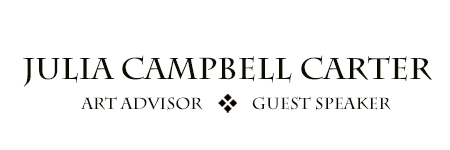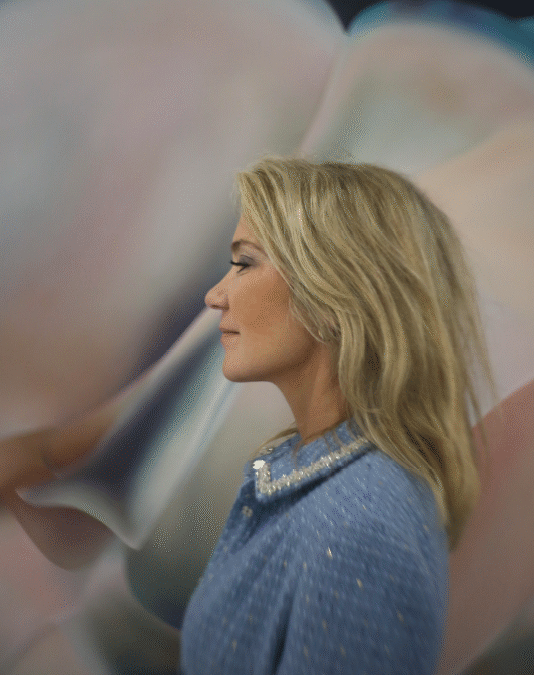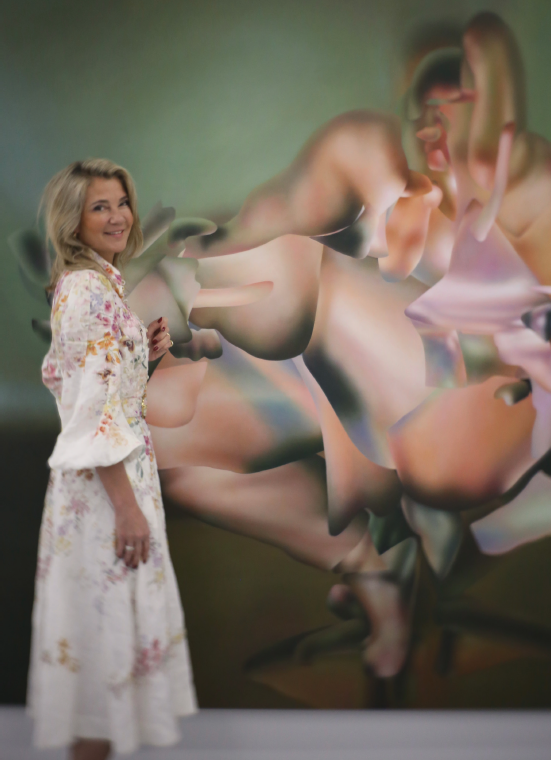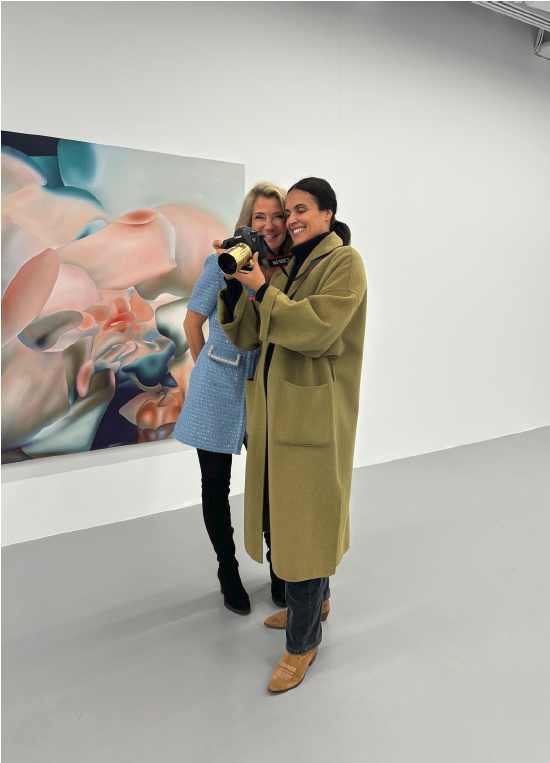Julia welcome to the art talk magazine special issue on photography! It was a few months ago when our common friend, collector Ramin Salsali, who is on our current issue’s cover launched during Art Dubai, introduced us in London. Since then we have been inspired by your impeccable instinct, and dedication to supporting artists, and unmatched ability to spot emerging talent with transformative potential.
Art Talk Magazine: Julia, you were an art collector before entering the art world as an advisor. Did we mention that you are the first art advisor that we interview in our magazine?! What inspired you to become an art advisor?
Julia Carter Campbell: To answer your question, my family has been collecting art for as long as I can remember. My father was particularly into “German Informel”. I basically grew up with art, as a family we spoke about it on a daily basis, planned our holidays around it and educated ourselves frequently about art in general. When I was 44 years old, I decided to change my career to become an art adviser after attending many art courses and in particular the year course at Christie’s of modern & contemporary art.
After a conversation with one of my closest friends, she prompted me to advise a Saudi collector in Switzerland. He had an important collection of impressionist art and wanted to get into contemporary art. I sold him his first contemporary art work which spurred me to advise more clients.
ATM: What is the role of an art advisor?
“Choosing art is always subjective. So, it is really important if you choose to work with anyone else that they have the ability to capture the essence of what you desire…”GDH , Yorkshire
Often talking to our art collectors , we feel how challenging it is to find the right advisor…lately, we were moderating a panel during Art Dubai, and discussing with some digital collectors how essential it is to connect to an experienced art advisor. Can you explain to our Art Talk community, how important it is to find the right art advisor?
JCC: The role of an art advisor is to first of all figure out what the client likes then advise him to build a cohesive collection of artworks around his taste. A new collection usually begins with one artwork and you build other works around it of the same subject, epoch or style etc. An art advisor also has to give the client comparables to show his client the market value of a work the client wants to purchase. The art advisor has to make sure that the client chooses an outstanding piece of artwork by the artist and not a mundane one that loses its value over time. According to Jussi Pylkkänen who was previously the global president of the auction house Christie’s, not every Picasso is worth the same, every artist has sometimes stronger and weaker phases, and therefore produces sometimes stronger and sometimes weaker works.
Lastly, buying art has an emotional aspect. An artwork has to provoke a reaction in the purchaser, this reaction can range from joy to rejection but it can not leave the purchaser cold. The art advisor has to truly tune into his client, therefore it is important to find the right art advisor.
ATM: You mention there are several reasons why people buy art; the top four ranked reasons for purchasing works of art are: Emotional Value; Portfolio Diversification; Investment Returns; and Social Value. Which one is for you the most important and why do you buy art ? What’s the best collecting advice you’ve been given?
JCC: For me by far the most important is the emotional value. As stated in the previous question buying art for me is mostly about provoking a reaction in my client. I believe the client should be convinced to hang on to the work because for most he/she likes to live with it and the artwork has provoked a reaction in them that makes them him want to hang on to this work. The best collecting advice I give to my clients is to collect cohesively. It is no good to collect a little Starlett here and there, the collection you have should be homogenic and cohesive.
ATM: And now what about Brexit? The London art market is still the second largest art market in the world. Do you still advise an art collector to do business in the UK? Does it still make sense for a gallerist to be present in London?
JCC: Brexit has a huge impact on selling and transporting art. Some of my collectors live in the US, others in Europe. Transporting art to the US from the UK has become more complicated due to the clearing at customs. A few months ago I sent a sculpture from the UK to Germany, it was sent back to the UK because the recipient was on Holiday and did not pay the tax at the customs quickly enough. Yes, I believe an art collector should still do business in London due to the unique collections you find in London. However, the 20% VAT on any purchase is not helpful, particularly when compared to other countries such as France where the VAT can be reclaimed if you are a foreign art collector. This is a reason for many galleries opting to set up galleries in Europe. Nevertheless, it still makes sense for a gallerist to be present in London because a lot of domestic clients live in the UK.
ATM: Julia you have co/curated many exhibitions. We saw Tilo Keiser in one of your shows. We inaugurated the Art salon in Zurich at Michele Buhofer ‘s gallery exhibiting Tilo. What are your criteria in selecting artists you curate?
JCC: I choose artists, whose artworks I find interesting and who are unique in their own right. I do not want to choose anyone who clones another artist’s style e.g. who works look like another Miro or Picasso. I choose artists whose works are unique either in the texture or materials or motives. Artists I find particularly interesting are Lola Alvarez, who works with Tintype or Gregor Hildebrandt, who incorporates VHS Tapes and Vinyl Records plus drawing to create unique works.
ATM: You travel through many art fairs around the world. Is there one that you love the most?
JCC: My favourite art fair is Art Basel Paris (formerly FIAC). The reason I like it so much is because the art on display is curated for talent not predominantly to sell. At other fairs. e.g. Frieze London, one finds certain artists at every other booth. It gives the feeling these artists are the most commercial and easiest to sell. I am not interested in finding the most commercial artists and easiest to sell, I am interested in finding artists with an interesting story, unique ideas and techniques and consistency.
ATM: And as a follow up question, this May you will attend Photo London with Swiss born artist with deep Spanish roots, photographer Lola Álvarez with whom you have curated “Tin Is My Type” a seamless narrative that highlights Álvarez’s unique creative vision. Can you tell us about your first encounter with Lola? When did you meet her and what made you choose this artist to present at Photo London this year?
JCC: Lola Alvarez and her husband bought a family home from my husband and I about 12 years ago. About that time I founded my art company. As neighbours we spoke a lot about our families, friends and what made our heart tick. Lola has since developed a precise and unique technique to create extraordinary Tintype photographs. I am very proud of her and that she managed to exhibit her Tintypes at two major public buildings / museums in Mallorca. She grows from strength to strength. When Lola and her family moved to London last year, she said her biggest wish was to exhibit at Photo London, so I said I will try my best to make this possible and here we go, I will exhibit Lola Alvarez in a solo show at Photo London from the 14th of May to the 18th of May.
ATM: Can you share with us some of the projects that you are working on currently, or that are in the future?
JCC: I am planning on hosting a solo exhibition of another artist here in London, who was recommended to me by a well known curator. I am also working on exhibiting a conceptional artist from Mexico in Rome. Furthermore, I am advising my existing clients expand their collection, and to position some of their works into major exhibitions.



